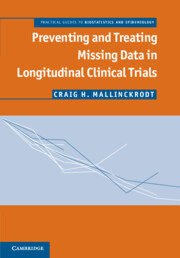Book contents
- Frontmatter
- Contents
- List of Figures
- List of Tables
- Acknowledgments
- Preface
- Part I Background and Setting
- Part II Preventing Missing Data
- Part III Analytic Considerations
- 6 Methods of Estimation
- 7 Models and Modeling Considerations
- 8 Methods of Dealing with Missing Data
- Part IV Analyses and The Analytic Road Map
- Bibliography
- Index
7 - Models and Modeling Considerations
Published online by Cambridge University Press: 05 February 2013
- Frontmatter
- Contents
- List of Figures
- List of Tables
- Acknowledgments
- Preface
- Part I Background and Setting
- Part II Preventing Missing Data
- Part III Analytic Considerations
- 6 Methods of Estimation
- 7 Models and Modeling Considerations
- 8 Methods of Dealing with Missing Data
- Part IV Analyses and The Analytic Road Map
- Bibliography
- Index
Summary
Introduction
The data from longitudinal clinical trials may be as varied as the trials themselves. Verbeke and Molenberghs (2000) provided a detailed and broad review of longitudinal data analyses and Molenberghs and Kenward (2007) provided a similar review specific to clinical trial data.
Given the variety of scenarios that may be encountered in longitudinal clinical trials, no universally best model or modeling approach exists. This implies that the analysis must be tailored to the situation at hand. To an extent, characteristics of the data are driven by the design of the study, and an appropriate analysis follows logically from the design.
Four important characteristics to consider when specifying analyses for longitudinal clinical trials include: (1) the mechanism(s) giving rise to the missing data; (2) the correlations between repeated measures on each patient; (3) the time trends; and (4) the statistical distribution that best describes the likelihood of various outcomes (e.g., normal distribution, binomial, etc.). Analyses appropriate for different missing data settings are discussed in Chapters 9 through 14, whereas the other data characteristics are discussed later in this chapter. These data characteristics influence what parameters need to be estimated, regardless of what method is used to estimate them.
- Type
- Chapter
- Information
- Preventing and Treating Missing Data in Longitudinal Clinical TrialsA Practical Guide, pp. 49 - 58Publisher: Cambridge University PressPrint publication year: 2013



